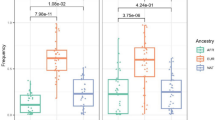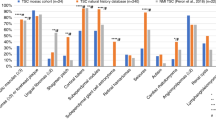Abstract
Each year an estimated 600 000 new leprosy cases are diagnosed worldwide. The spectrum of the disease varies widely from limited tuberculoid forms to extensive lepromatous forms. A measure of the risk to develop lepromatous forms of leprosy is provided by the extent of skin reactivity to lepromin (Mitsuda reaction). To address a postulated oligogenic control of leprosy pathogenesis, we investigated in the present study linkage of leprosy susceptibility, leprosy clinical subtypes, and extent of the Mitsuda reaction to six chromosomal regions carrying known or suspected leprosy susceptibility loci. The only significant result obtained was linkage of leprosy clinical subtype to the HLA/TNF region on human chromosome 6p21 (Pcorrected=0.00126). In addition, we established that within the same family different HLA/TNF haplotypes segregate into patients with different leprosy subtypes directly demonstrating the importance of this genome region for the control of clinical leprosy presentation.
This is a preview of subscription content, access via your institution
Access options
Subscribe to this journal
Receive 6 digital issues and online access to articles
$119.00 per year
only $19.83 per issue
Buy this article
- Purchase on Springer Link
- Instant access to full article PDF
Prices may be subject to local taxes which are calculated during checkout


Similar content being viewed by others
Accession codes
References
Jacobson RR, Krahenbuhl JL . Leprosy. Lancet 1999; 353: 655–660.
WHO. Leprosy—global situation. Weekly Epidemiol Rec 2000; 75: 226–231.
Ridley DS, Jopling WH . Classification of leprosy according to immunity. A five-group system. Int J Lepr Other Mycobacter Dis 1966; 34: 255–273.
Alcais A, Sanchez FO, Thuc NV et al. Granulomatous reaction to intradermal injection of lepromin (Mitsuda reaction) is linked to the human NRAMP1 gene in Vietnamese leprosy sibships. J Infect Dis 2000; 181: 302–308.
Casanova JL, Abel L . Genetic dissection of immunity to mycobacteria: The human model. Annu Rev Immunol 2002; 20: 581–620.
Chakravarti MR, Vogel F . A twin study on leprosy. In: Becker PE (ed). Topics in Human Genetics. Georg Thieme Verlag: Stuttgart, 1973; pp. 1–24.
Abel L, Vu DL, Oberti J et al. Complex segregation analysis of leprosy in southern Vietnam. Genet Epidemiol 1995; 12: 63–82.
Meyer CG, May J, Stark K . Human leukocyte antigens in tuberculosis and leprosy. Trends Microbiol 1998; 6: 148–154.
Abel L, Sanchez FO, Oberti J et al. Susceptibility to leprosy is linked to the human NRAMP1 gene. J Infect Dis 1998; 177: 133–145.
Bellamy R, Ruwende C, Corrah T et al. Variations in the NRAMP1 gene and susceptibility to tuberculosis in West Africans. N Engl J Med 1998; 338: 640–644.
Greenwood CM, Fujiwara TM, Boothroyd LJ et al. Linkage of tuberculosis to chromosome 2q35 loci, including NRAMP1, in a large aboriginal Canadian family. Am J Hum Genet 2000; 67: 405–416.
Gao PS, Fujishima S, Mao XQ et al. Genetic variants of NRAMP1 and active tuberculosis in Japanese populations. International Tuberculosis Genetics Team. Clin Genet 2000; 58: 74–76.
Siddiqui MR, Meisner S, Tosh K et al. A major susceptibility locus for leprosy in India maps to chromosome 10p13. Nature Genet 2001; 27: 439–441.
Roy S, Frodsham A, Saha B et al. Association of vitamin D receptor genotype with leprosy type. J Infect Dis 1999; 179: 187–191.
de Vries RR, Mehra NK, Vaidya MC et al. HLA-linked control of susceptibility to tuberculoid leprosy and association with HLA-DR types. Tissue Antigens 1980; 16: 294–304.
Mehra NK . Role of HLA linked factors in governing susceptibility to leprosy and tuberculosis. Trop Med Parasitol 1990; 41: 352–354.
Zerva L, Cizman B, Mehra NK et al. Arginine at positions 13 or 70-71 in pocket 4 of HLA-DRB1 alleles is associated with susceptibility to tuberculoid leprosy. J Exp Med 1996; 183: 829–836.
Roy S, McGuire W, Mascie-Taylor CG et al. Tumor necrosis factor promoter polymorphism and susceptibility to lepromatous leprosy. J Infect Dis 1997; 176: 530–532.
Rajalingam R, Singal DP, Mehra NK . Transporter associated with antigen-processing (TAP) genes and susceptibility to tuberculoid leprosy and pulmonary tuberculosis. Tissue Antigens 1997; 49: 168–172.
Roche PW, Theuvenet WJ, Britton WJ . Risk factors for type-1 reactions in borderline leprosy patients. Lancet 1991; 338: 654–657.
Jepson A, Banya W, Sisay-Joof F et al. Quantification of the relative contribution of major histocompatibility complex (MHC) and non-MHC genes to human immune responses to foreign antigens. Infect Immun 1997; 65: 872–876.
Marquet S, Abel L, Hillaire D et al. Genetic localization of a locus controlling the intensity of infection by Schistosoma mansoni on chromosome 5q31–q33. Nature Genet 1996; 14: 181–184.
Garcia A, Marquet S, Bucheton B et al. Linkage analysis of blood Plasmodium falciparum levels: interest of the 5q31–q33 chromosome region. Am J Trop Med Hyg 1998; 58: 705–709.
Shaw MA, Donaldson IJ, Collins A et al. Association and linkage of leprosy phenotypes with HLA class II and tumour necrosis factor genes. Genes Immun 2001; 2: 196–204.
Fine PE, Wolf E, Pritchard J et al. HLA-linked genes and leprosy: a family study in Karigiri, South India. J Infect Dis 1979; 140: 152–161.
van Eden W, Gonzalez NM, de Vries RR, Convit J, van Rood JJ . HLA-linked control of predisposition to lepromatous leprosy. J Infect Dis 1985; 151: 9–14.
de Vries RR, Fat RF, Nijenhuis LE, van Rood JJ . HLA-linked genetic control of host response to Mycobacterium leprae. Lancet 1976; 2: 1328–1330.
Dessoukey MW, el-Shiemy S, Sallam T . HLA and leprosy: segregation and linkage study. Int J Dermatol 1996; 35: 257–264.
Xu KY, de Vries RR, Fei HM et al. HLA-linked control of predisposition to lepromatous leprosy. Int J Lepr Other Mycobacter Dis 1985; 53: 56–63.
Languillon J . Classification immunologique de la lepre. Bull Soc Pathol Exot 1964; 57: 424–431.
Udalova IA, Nedospasov SA, Webb GC, Chaplin DD, Turetskaya RL . Highly informative typing of the human TNF locus using six adjacent polymorphic markers. Genomics 1993; 16: 180–186.
Eskdale J, Turestkaya RL, Armstrong C et al. A polymorphic microsatellite marker in the human p55 TNF receptor, CD120a. Genes Immun 2000; 1: 228–230.
Scott P, Ouimet D, Valiquette L et al. Suggestive evidence for a susceptibility gene near the vitamin D receptor locus in idiopathic calcium stone formation. J Am Soc Nephrol 1999; 10: 1007–1013.
Holland PM, Abramson RD, Watson R, Gelfand DH . Detection of specific polymerase chain reaction product by utilizing the 5′—3′ exonuclease activity of Thermus aquaticus DNA polymerase. Proc Natl Acad Sci USA 1991; 88: 7276–7280.
Lee LG, Connell CR, Bloch W . Allelic discrimination by nick-translation PCR with fluorogenic probes. Nucleic Acids Res 1993; 21: 3761–3766.
Holmans P . Likelihood-ratio affected sib-pair tests applied to multiply affected sibships: issues of power and type I error rate. Genet Epidemiol 2001; 20: 44–56.
Alcais A, Abel L . Linkage analysis of quantitative trait loci: sib pairs or sibships? Hum Hered 2000; 50: 25 125–25 126.
Abel L, Alcais A, Mallet A . Comparison of four sib-pair linkage methods for analyzing sibships with more than two affecteds: interest of the binomial maximum likelihood approach. Genet Epidemiol 1998; 15: 371–390.
Abel L, Muller-Myhsok B . Robustness and power of the maximum-likelihood-binomial and maximum-likeli-hood-score methods, in multipoint linkage analysis of affected-sibship data. Am J Hum Genet 1998; 63: 638–647.
Alcais A, Abel L . Maximum-Likelihood-Binomial method for genetic model-free linkage analysis of quantitative traits in sibships. Genet Epidemiol 1999; 17: 102–117.
Alcais A, Philippi A, Abel L . Genetic model-free linkage analysis using the maximum-likelihood- binomial method for categorical traits. Genet Epidemiol 1999; 17 (Suppl 1): S467–S472.
Kruglyak L, Daly MJ, Reeve-Daly MP, Lander ES . Parametric and nonparametric linkage analysis: a unified multipoint approach. Am J Hum Genet 1996; 58: 1347–1363.
Acknowledgements
This work was supported by Action Incitative Blanche, Fondation BNP-Paribas, Fondation pour la Recherche Médicale and Fondation Schlumberger (AA and LA), and by grant MT 15662 from the Canadian Institute of Health Research (CIHR) to ES. MTM is supported by a graduate fellowship of the Brazilian Coordenacao de Aperfeicoamento de Pessoal de Nivel Superior (CAPES). ES is a CIHR Career Investigator.
Author information
Authors and Affiliations
Corresponding author
Rights and permissions
About this article
Cite this article
Mira, M., Alcais, A., di Pietrantonio, T. et al. Segregation of HLA/TNF region is linked to leprosy clinical spectrum in families displaying mixed leprosy subtypes. Genes Immun 4, 67–73 (2003). https://doi.org/10.1038/sj.gene.6363911
Published:
Issue Date:
DOI: https://doi.org/10.1038/sj.gene.6363911
Keywords
This article is cited by
-
Leprosy pathogenetic background: a review and lessons from other mycobacterial diseases
Archives of Dermatological Research (2009)
-
Genome-wide scans for leprosy and tuberculosis susceptibility genes in Brazilians
Genes & Immunity (2004)



